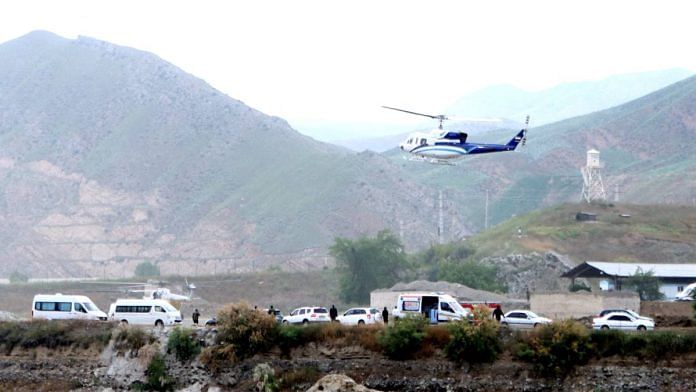New Delhi: The helicopter that crashed Sunday killing Iran’s President Ebrahim Raisi and Foreign Minister Amir Abdollahian and other high-ranking officials was a US-manufactured Bell 212.
Initial reports on the crash suggest that it was flying through mountains in heavy fog.
While it is not known when Tehran procured the helicopter, according to a defence expert, it may have been acquired, along with several other US aircraft, including fighter jets, during the rule of Mohammad Reza Shah Pahlavi, the last monarch of Iran.
Afroz Khan, research analyst at the New Delhi-based Manohar Parrikar Institute for Defence Studies and Analyses, told ThePrint: “Shah-ruled Iran was one of the closest US allies in the region.”
Other US aircraft used by Iran include the Grumman F-14 Tomcat and Boeing Chinook CH-47. The Asian country also used the McDonnell Douglas F-4 Phantom II fighter jet, which is not in operational use anymore.
These aircraft were procured before the Iranian Revolution of 1979, when the Shah regime came to an end. The revolution was followed by a breach in relations between the US and Iran, and imposition of American sanctions on the nation. This made it difficult for the US-origin aircraft to undergo proper maintenance.
“Iran went through a lot of difficulty in maintaining the aircraft. It began procuring the spare parts from black markets and even through third parties. Certain equipment like missiles were modified by Iran to meet requirements,” Khan said, explaining how Tehran managed to keep these aircraft operational.
An Arms Control Association report of 2007 said that Iran purchased several parts for F-14 fighter planes from a US military surplus store, according to the results of a federal investigation reported by the Associated Press (AP). The report prompted the Pentagon to suspend sales of the F-14 components.
The AP had reported that foreign individuals and companies bought the parts and sold them to Iran. “The incident was just one piece of a larger ring of illegally sold military surplus parts that found their way to China and Iran,” the report stated.
At the time, Iran was in search of several key components for its ageing F-14s. These parts include electronics and hydraulics, guidance and control system, J85 engines, Vulcan 20mm cannon and ammunition drums and Sparrow medium-range missiles, according to the Arms Control Association report.
Due to the rivalry between Iran and the US, trade between the two countries has become almost nil at this point in time. The US, in fact, is quick even to sanction countries trading with Iran.
Also Read: India, China & Turkey may continue to buy Iranian oil even after US sanctions
The Bell 212 helicopter
The Bell 212 is a two-blade, medium helicopter that first flew in 1968. It was originally manufactured by Bell Helicopter but production was moved to Canada in 1988, according to the helicopter solutions company Coldstream Helicopters.
The Bell 212 was marketed to civilian operators and has up to a 15-seat capacity, including the crew. It can carry an external load of up to 2,268 kg and has an average cruise speed of 190 km per hour.
Equipped with two Pratt & Whitney Canada turboshaft engines PT6T-3B Twin-Pac, the helicopter is widely used for carrying people, deploying aerial firefighting gear and for ferrying cargo and mounting weapons.
The Bell 212 has reportedly also been deployed in various UN peacekeeper operations in the Middle East and Africa.
FlightGlobal’s 2024 World Air Forces directory states that the Iranian air force and navy operate a total of 10 such helicopters.
Furthermore, several organisations across the world use the Bell 212 chopper, including Japan’s Coast Guard, law enforcements agencies and fire departments in the US, and Thailand’s national police, according to Reuters.
The helicopter that crashed was configured to carry government passengers, the news agency reported.
The Bell 212 has been involved in several accidents over the years. One was in September last year near Dubai, when UAE news agency WAM reported that a Bell 212 helicopter owned by Aerogulf “fell down in the Gulf sea as it was on a night training trip with two pilots of Egyptian and South African nationalities onboard”. Search and rescue teams later recovered the wreckage.
The National News reported Monday that a number of factors may have caused the Bell 212 carrying Raisi and the others to crash.
It also said that over the years, Iran’s fleet of US-made aircraft had “slowly dwindled as it cannibalised parts from some to keep others operational”.
During backchannel talks between US and Iran in 1986, Iran managed to obtain some spare parts for the helicopter from the US over US hostages held by Iran-backed groups in Lebanon, according to the report, which added that Iran also resorted to smuggling networks.
Bell denied supplying the parts but United Technologies Corp, a US defence contractor, later confirmed the shipment, the National News report said.
In 2011, Spanish authorities foiled a plot by Venezuela to sell Bell 212 spare parts and in fact even the complete spare parts to Iran, according to the report.
On the chopper crash, National News quoted the European Safety Agency as saying that being surrounded by high mountains and flying over deep valleys can disorient a pilot and navigating through such terrain can be tiring, mentally as well as physically. It said that wind speed and direction can be unpredictable in deep valleys. This can lead to significant fluctuations in airspeed potentially leading, in extremes, to loss of control.
(Edited by Nida Fatima Siddiqui)
Also Read: Forty years on from the Iranian Revolution, could the country be at risk of another one?






